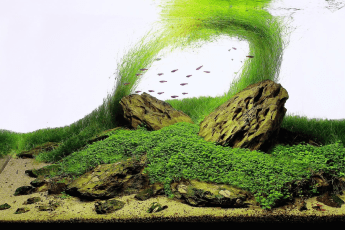Aquascaping, the art of designing and arranging aquatic elements within an aquarium, has evolved into a captivating blend of creativity and science. One often-overlooked aspect that plays a pivotal role in achieving aesthetic balance is the skillful use of negative space. In this article, we will explore the significance of negative space in aquascaping and how it can elevate the visual impact of your underwater masterpiece.
Understanding Negative Space:
Negative space, also known as “empty” or “white” space, is the unoccupied area within an aquarium. Skilled aquascapers recognize that the strategic placement of plants, rocks, and other elements is just as crucial as the elements themselves. Negative space allows for a harmonious composition, drawing the viewer’s attention to the beauty of simplicity and creating a sense of balance.
Enhancing Visual Depth:
One of the primary advantages of incorporating negative space is the enhancement of visual depth within the aquarium. By leaving areas of the tank unadorned, aquascapers can create an illusion of distance, transforming the confined space into a visually expansive environment. This technique not only adds a sense of realism but also provides a more engaging viewing experience for enthusiasts.
Focal Points and Emphasis:
Negative space serves as a powerful tool for emphasizing key features within an aquascape. By strategically framing or isolating certain elements, such as a meticulously arranged rock formation or a vibrant cluster of aquatic plants, aquascapers can guide the viewer’s gaze and establish a focal point. This deliberate use of negative space contributes to a more aesthetically pleasing and well-balanced composition.
Promoting Naturalism:
In nature, open spaces are essential for aquatic life to move freely and establish territories. Emulating this aspect in aquascaping not only promotes the well-being of the aquarium’s inhabitants but also contributes to a more natural and serene ambiance. By carefully considering negative space, aquascapers can create environments that mirror the delicate equilibrium found in natural aquatic ecosystems.
Guidelines for Effective Use:
To harness the full potential of negative space, aquascapers should follow a few guidelines. First, avoid overcrowding the aquarium with excessive elements, as this can disrupt the visual balance. Instead, opt for a thoughtful arrangement that allows negative space to complement and accentuate the chosen focal points. Additionally, consider the overall theme and purpose of the aquascape to ensure that negative space aligns with the intended aesthetic.
Conclusion:
In the world of aquascaping, mastering the use of negative space is a hallmark of true artistry. By recognizing its role in enhancing visual depth, emphasizing focal points, and promoting naturalism, aquascapers can elevate their creations to new heights. Embrace the subtlety of negative space, and unlock the full potential of your aquatic masterpiece, creating an immersive and visually stunning underwater world.



